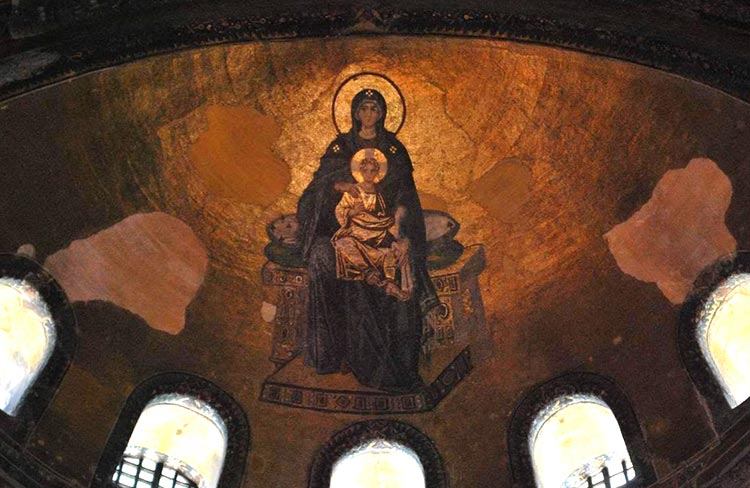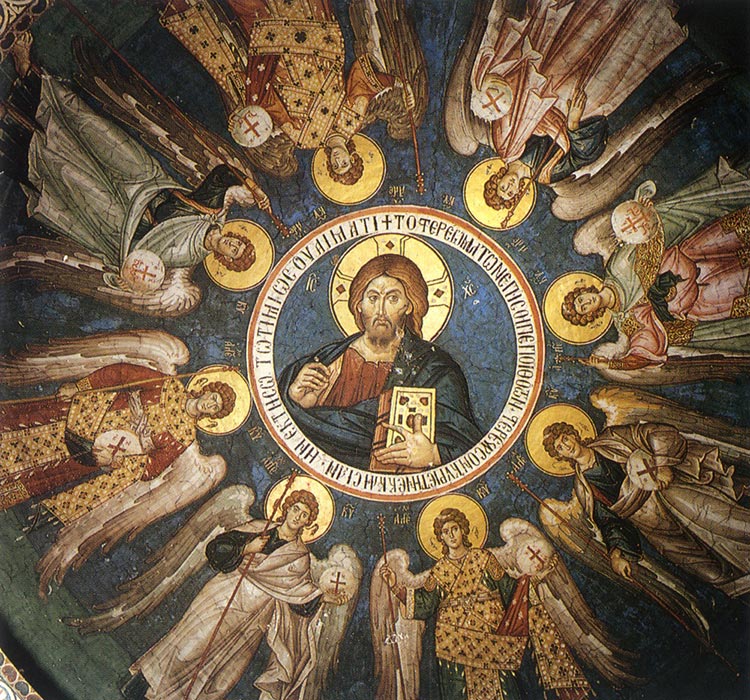
Christian Philosophy & Culture
The Christian Church: The Inner Decoration (Part 3 of 4)
We shall speak here only of the classic type of decoration in its principal features, in order to complete the general picture of a church. From the eleventh century-that is to say, from the post-iconoclastic period, when the system of church decoration was definitively determined-until the end of the seventeenth century, the arrangement of iconographical themes remained unchanged, at any rate in the monuments which have survived. Naturally, this stability and uniformity can be seen only in the general features and not in the details of the decoration.
The sanctuary, as we have already seen, represents that which is higher than heaven, which surpasses the created world, the very dwelling place of God. It is in the sanctuary that the sacrament of the Eucharist is performed, and consequently those things which are most closely connected with it are here represented. The first row of paintings, beginning at the bottom, represents the Fathers who wrote the Liturgy, and with them other saints of the hierarchy and holy deacons, in their role as co-celebrators. Higher up is represented the Eucharist itself, under the guise of the communion of the apostles, in both kinds, bread and wine. Higher still, above the Eucharist, is the image of the Mother of God, directly behind the altar. Her place so close to the sacrament corresponds to her place in the Eucharistic Canon, where she is mentioned at the head of the whole Church, immediately after the accomplishment of the Eucharistic mystery. Moreover, the Mother of God personifies the Church itself, for she bore in herself the Creator of the world, Whom the whole world cannot contain. That is why at this place in the sanctuary she is generally represented in the orante form, that is, interceding before God for the sins of the world, which is her role and the role of the Church. The representation of the Virgin as intercessor here, where the sacrifice takes place, acquires a quite particular significance. The elevation of the hands is a gesture which completes the sacrifice. It is the inseparable final completion of it, directing the offering towards God. This is why we see this same gesture made by the priest during the Liturgy. This elevation of the hands has nowhere been prescribed. But it is a gesture which has become an inseparable part of the Liturgy, so closely is it connected with the sacrifice; it is an incarnation of prayer.
 Above: Mosaic of the Virgin and Child in Hagia Sofia, Istanbul, Turkey
Above: Mosaic of the Virgin and Child in Hagia Sofia, Istanbul, Turkey
Since the sanctuary is the place where the unbloody sacrifice instituted by Christ Himself is offered, the image of Christ is placed above that of the Virgin. It is He Who is Himself the sacrifice offered and the High Priest Who offers the sacrifice, and His image has a quite particularly Eucharistic significance here.
Finally, in the hemisphere of the arch of the sanctuary, Pentecost is represented. This image indicates the presence of the Holy Spirit, by virtue of Whom the sacrament of the Eucharist takes place.
This brief summary allows us to see the fundamental importance of the sanctuary: it is the place which sanctifies the whole church. Consequently, the decoration of the sanctuary is, so to speak, the most concentrated of the whole church. The opening of the Royal Doors during the Liturgy symbolizes heaven itself being thrown open to allow us to catch a glimpse of its splendour.
The nave of the church, as we know already, symbolizes the transfigured creation, the new earth and the new heaven, and at the same time the Church. That is why the Head of the Church, Christ Pantocrator, is painted in the cupola. The Church was foretold by the prophets and founded on the apostles, and these are represented immediately underneath the image of Christ. Then come the four evangelists in the four corners, proclaiming the good news and preaching the Gospel in the four quarters of the world. The pillars supporting the building are decorated with images of the "pillars" of the Church: martyrs, hierarchs and ascetics. On the walls are displayed the principal events of sacred history, especially those which the liturgical feasts celebrate as syntheses of Christian instruction, "pearls of divine dogmas", in the words of St. Germanus of Constantinople. Finally, the western wall portrays the Last Judgement, the end of the history of the Church and the beginning of the age to come.
 Above: Christ Pantocrator in a Greek Orthodox church
Above: Christ Pantocrator in a Greek Orthodox church
In this way the decoration of Orthodox churches does not depend on individual ideas of artists; the iconographical themes are distributed according to the significance of the church as a whole and the significance of each of its parts.
The Church of the Old Testament made use of symbols, as did all other religions. This symbolism prefigured the coming of Christ. But Christ has come, and yet the symbolism largely inherited from Israel continues in the new Church and forms a dimension of its worship which it cannot dispense with. Indeed, the whole Liturgy has been penetrated by symbolism, in its language, gestures and images. This symbolism takes on the character of an initiation into the mysteries which are taking place in the church, and reveals a reality which is always present, but which cannot be expressed directly. This reality is the Kingdom of God, the first-fruits of which exist as a spiritual and material reality, a physical presence, in the Eucharist, which is the principal sacrament of the Church. The Church places before our eyes the image of that Kingdom, so that we may partake of this sacrament with greater awareness and in consequence feel ourselves a part of the Kingdom of God, so that we may share with the whole Church in preparing for this Kingdom, which is the supreme goal of the world. The Church uses visible things to bring us nearer to the invisible ones which are beyond the reach of our senses. For "we are not able to bring ourselves to contemplate spiritual things without some intermediary, and in order to do this we need something close and familiar", says St. John of Damascus (10). In other words, worship and all that forms part of it is a means to our sanctification, our deification. Everything in a church is directed towards this end. After the fall, the Old Testament was the first step towards this goal. It was not yet a direct preparation for the age to come; it was the preparation for the second stage, the New Testament. What was for the Old Testament the future is now the present, and this present is preparing us for and leading us towards the future, which the Fathers call the heavenly Jerusalem . St. John Damascene sums this up by referring to St. Paul's Epistle to the Hebrews: "Mark", he says, "that the law and all that has been instituted by the law, as well as all the worship that we are at present rendering, these are holy things, done by man, which through the intermediary of the material are lifting us up towards God Who is immaterial. The law and all that has been instituted by the law (that is to say all the Old Testament) was a prefiguring of our present worship. And the worship which we now offer is an image of the good things to come". These good things (that is to say reality itself) are the heavenly Jerusalem, immaterial, not made by human hands, as the Apostle says: "We have here no continuing city, but seek one that is to come" (Hebrews xiii, 14), that is, the heavenly Jerusalem "whose builder and maker is God" (Hebrews xi, 10). In fact, all that has been instituted by the law and by our present worship only exists for the sake of the heavenly Jerusalem (11).
Our churches are images of the heavenly Jerusalem . A church is a prefiguring of the peace to come, of the new heaven and the new earth, where all the creatures shall gather together around their Creator. The building and decoration of churches are based on this image. The Fathers do not prescribe any style of architecture nor specify how the building should be decorated, nor how the icons should be painted. Everything is rooted in the total meaning of the Church, and follows a rule of art analogous to the rules by which the Liturgy was created. In other words, we have a very clear and precise general formula to direct our efforts, which leaves entire freedom for the action of the Holy Spirit in us. This formula is passed on from generation to generation by the living tradition of the Church, a tradition which goes back not only to the apostles but even to the Old Testament. If we live in this tradition, we understand the church as the holy Fathers understood it and we decorate it accordingly. If we move away from it, we bring in elements which have no connexion with the meaning of the church, and we often secularize the church by introducing things from everyday life.


